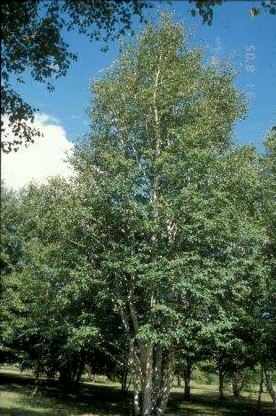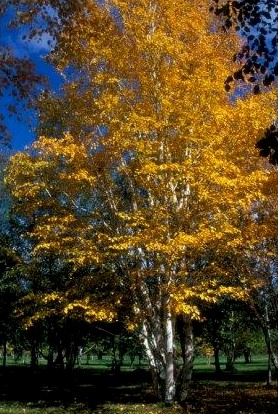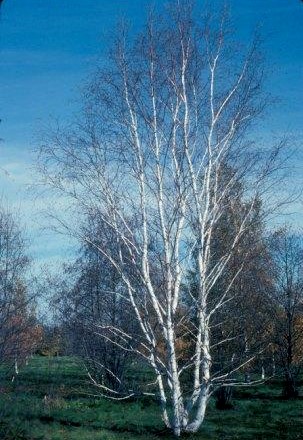Prairie Dream® Paper Birch – Betula papyrifera ‘Varen’ (RFM-32)
Description:



Prairie Dream® is a paper birch with exceptional snow-white exfoliating bark, quality dark green foliage and excellent golden-yellow autumn foliage coloration. Superior adaptation and stress tolerance are valuable attributes of this cultivar. Resistant to bronze birch borer attack since 1975 in evaluations. Prairie Dream® is excellent grown single or multi-trunked.
Hardiness:
USDA hardiness zone 2b-6(7)
Mature Size:
Height: 50'
Spread: 40'
Form (Shape):
Semi-pyramidal to upright-oval, becoming broadly-oval with age.
Growth Rate:
Moderate to fast.
Foliage:
Deciduous
Summer: Lustrous medium to dark green with doubly serrated margin.
Autumn: Yellow with high quality foliage.
Texture:
Medium
Flower:
Slender catkins, no ornamental value.
Fruit:
Small nutlet, no ornamental value.
Special Features:
Snow-white exterior bark peels freely exposing orange inner bark.
Light Preferences:
Full sun to part shade.
Soil Preferences:
Prefers moist well-drained soils and is pH adaptable.
Propagation:
Tissue culture and/or softwood cuttings.
Ornamental Attributes:
Prairie Dream® Paper Birch has dark green foliage throughout the season and turns an outstanding gold in the fall. The peeling white bark is extremely showy and adds significant winter interest especially when framed against evergreens.
Landscape Attributes:
Recommended as a landscape specimen tree. Prairie Dream® is more adaptable and stress tolerant than the species. Very low maintenance and is highly resistant to bronze birch borer. Performs better than Betula pendula.
Comments:
Seedling selection from western North Dakota from the Kildeer Mountains. Deer resistant. Apply mulch around root zone to prevent from drying out.
Patent Status:
- U.S. Trademark registered - Prairie Dream®
- Canadian Trademark registered
Licensing Status:
This cultivar is available for non-exclusive licensing.
Downloads:
Download the PDF Datasheet (PDF, 381.21 KB)
Inquire about this technology >